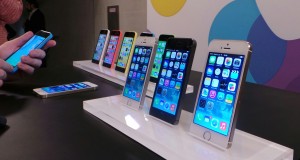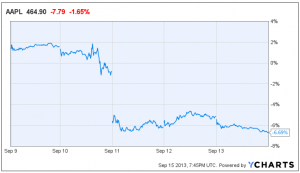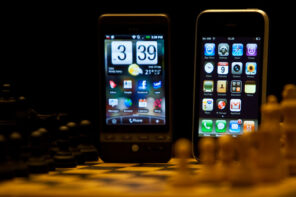On September 10th, Apple unveiled its brand-new line of iPhone devices. In stark contrast to previous iPhone launches, Apple released 2 new models of their smartphone device simultaneously, including 6 new colour options. Also unlike recent years, effectively every detail of the new iPhones had been accurately predicted by technology analysts prior to September 10th.
The new models, the iPhone 5s and iPhone 5c, have been the talk of tech forums and discussion boards for weeks. However, Apple’s stock performance following the announcement was lackluster, falling 7% within the ensuing two days. While some may be quick to point fingers at a lack of any surprise features, the reasoning behind the tech giant’s stock slide actually goes far deeper.
The iPhone 5s packs a fingerprint sensor built into the home button. This feature could be the start of a new wave of smartphones where biometric identifiers replace all those passwords we need to remember across the web services we use. Apple is calling this feature Touch ID and it will allow iPhone users to unlock the device, login to apps and web services, and even pay for iTunes songs and App Store purchases just by touching the home sensor.
Apple likes to flaunt that more pictures are taken every day on the iPhone than any other device. For most people, the iPhone is all the digital camera they ever need. It therefore makes perfect sense that Apple would set out to improve the iSight camera on the new iPhone. The 5s camera is equipped with dual-colour flash which to create the best possible picture. For consumers that are into extreme sports, the new iPhone can also record HD video at 120 frames per second, so you can see your Backside 1080 in slow motion.
The iPhone 5c is available is five different colours, similar to the iPod Touch. It is powered by the previous generation’s A6 processor. The only other material difference is that it doesn’t pack the new iSight camera and flash, and is plastic rather than metal. Apple is aiming to open the iPhone up to lower-tier consumers in the market, with the 5c acting as its low cost option. Of course it doesn’t have the chic metal casing, but the multi-colour plastic has generated a good deal of positive feedback already.
But If the iPhones are so great, why did Apple stock fall ~7% within 2 days of the release ? That is $30 billion in market value. The truth is that the stock performance did not have that much to do with the actual quality of the new devices. The market penalized Apple stock for coming up short on two major issues: The failure to announce a deal with China Mobile, and the pricing of the iPhone 5c.
Apple shareholders had speculated the possibility that Apple would announce a deal with China Mobile, which would have given the 700 million customers of China’s largest telecom provider the option to purchase the new iPhone. That is double the U.S. population! China Mobile has never offered the iPhone, and the rumoured deal was expected to be a major growth. On September 10th, after the markets closed, Apple held a keynote event in Beijing. Investors speculated that Apple and China Mobile would announce an agreement. Instead, Apple simply streamed the video of Tim Cook from his keynote in Cupertino, California just a few hours earlier. This confirmed that there would be no China Mobile deal.
The other major disappointment was the price of the iPhone 5c. If you read up on the iPhone 5c prior to the release, many journalists joked the “c” stood for iPhone “cheap”. The investor community believed they were getting a low-price phone intended to steal market share in emerging markets. The theory was that Apple would be going head-to-head with Samsung in the non-premium level device market, where the latter has an undeniable stronghold.
However, it turns out that Apple simple isn’t comfortable attaching a low price to anything bearing the prestigious Apple logo. They decided to price the iPhone 5c at $549 without a contract, just $100 less than the 16gb version of the 5s. Analysts were expecting a price tag in the range of $300-400, with capabilities and hardware further removed from the 5s than simply the absence of dual flash, metal casing, and new processors.
Apple shareholders clearly didn’t get the news they were looking for on September 10th, but that does not mean Apple will not have a successful run with the new line of iPhones. After a year of declining stock prices, Apple executives are well aware that their investors are getting impatient. Only time will tell if Apple was correct to charge more than expected for the iPhone 5c. Analysts estimate pre-orders to have exceeded 1 million devices at time of print. Last year, Apple sold 2 million iPhone 5 devices in the first weekend.
With 5c sales numbers already strong, and hot demand for iPhone 5s when it debuts in stores on September 20th, Apple may be on track to sell more iPhones in the opening weekend than ever before.









